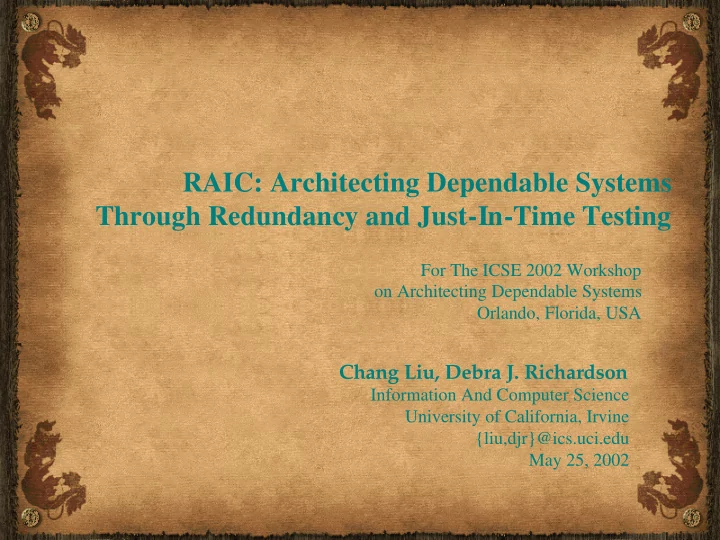

RAIC: Architecting Dependable Systems Through Redundancy and Just-In-Time Testing For The ICSE 2002 Workshop on Architecting Dependable Systems Orlando, Florida, USA Chang Liu, Debra J. Richardson Information And Computer Science University of California, Irvine {liu,djr}@ics.uci.edu May 25, 2002
Outline � RAIC overview. � An example of dependable application in the RAIC architectural style. � Conclusions and related work. 2
RAIC Overview � Redundant Arrays of Independent Components � A redundant software component array is a group of independent software component that provide identical, similar, or related functions. [Liu, Richardson (2002)] UCI-ICS-TR-02-09. [Liu, Richardson (2002)] COMPSAC 2002 Workshop of Dependable On-line Upgrading of Distributed Systems, Oxford. 3
The RAIC Architectural Style � Goal: to reduce component integration cost. [Liu, Richardson (2002)] Submitted to FSE-10.
RAIC Details � Component Array Types – Component Types – Component Relations � RAIC Controllers � RAIC Levels � RAIC Invocation Models
Array Types � Static � Dynamic – UDDI – Jini lookup service
Component Types � Stateless � Stateful – State-preserving function calls – State-changing function calls – State-defining function calls – State-independent return values – State-dependent return values
Component Relations � Interface relations � Functionality relations � Domain relations � Snapshot relations � Relations on security, invocation prices, or other aspects
RAIC Levels � RAIC-1: Exact mirror redundancy � RAIC-2: Approximate mirror redundancy � RAIC-3: Shifting lopsided redundancy � RAIC-4: Fixed lopsided redundancy � RAIC-5: Reciprocal redundancy � RAIC-6: Reciprocal domain redundancy � RAIC-0: No redundancy
RAIC Invocation Models � RAIC-a: Sequential invocation � RAIC-b: Synchronous parallel invocation � RAIC-c: Asynchronous parallel invocation [Liu, Richardson (2002)] Preparing for Foclasa (Czech).
Light Component Code Segment (in C#)
Light Application 1 Code (in C#)
Light Application 2 Code
The Light Components With Versions � Light version 1.0.0.1 – Allows arbitrary calls to all three methods � Light version 1.0.0.2 – Must call TurnOn() before calling SetIntensity() or TurnOff() – Cannot call TurnOff() if the light is already off.
LightApp1, LightApp2, the Light Components, and LightRAIC
LightApp1 enjoys Light:1.0.0.2
LightApp2 reverts to Light:1.0.0.1
Just-In-Time Component Testing � JIT component testing versus traditional software testing. � JIT component testing versus perpetual testing. [Osterweil, L. J., L. A. Clarke, et al. (1996)] � JIT component testing versus self-checking software or components. [Yau, S. S. and R. C. Cheung (1975)] [Liu, C. and D. J. Richardson (1998)]
JIT Testing VS Traditional Testing Happens even after application � deployment. Uses heuristics and other means in � place of traditional test oracles. Uses mostly live input data. � Efficiency extremely important for � predetermined test inputs. Should not change component � states.
JIT Testing VS Perpetual Testing � Perpetual testing is optional and removable. � JIT testing in conjunction with the RAIC controller is an integral part of the final product.
JIT Testing VS Self-Checking Components � JIT testing mechanisms are part of the RAIC controller. � Self-checking mechanisms are part of the component.
Component State Recovery � Snapshot-based � Invocation-history-based – Method properties – Invocation history trimming � Could be enhanced with component dependency information [Liu, Richardson (2002)] ICSE02/ CBSE5.
Related Work � Barga and Lomet: Phoenix � Cook and Dage: Hercules � S. S. Yau and R. C. Cheung: Self- checking software
Conclusions � Dependability-through-redundancy can be achieved by adopting the RAIC architecture style. � Just-in-time component testing and component state recovery techniques support RAIC to achieve the above goal.
Recommend
More recommend